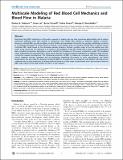| dc.contributor.author | Fedosov, Dmitry A. | |
| dc.contributor.author | Lei, Huan | |
| dc.contributor.author | Caswell, Bruce | |
| dc.contributor.author | Suresh, Subra | |
| dc.contributor.author | Karniadakis, George E. | |
| dc.date.accessioned | 2012-02-08T18:30:29Z | |
| dc.date.available | 2012-02-08T18:30:29Z | |
| dc.date.issued | 2011-12 | |
| dc.date.submitted | 2011-01 | |
| dc.identifier.issn | 1553-734X | |
| dc.identifier.issn | 1553-7358 | |
| dc.identifier.uri | http://hdl.handle.net/1721.1/69043 | |
| dc.description.abstract | Red blood cells (RBCs) infected by a Plasmodium parasite in malaria may lose their membrane deformability with a relative membrane stiffening more than ten-fold in comparison with healthy RBCs leading to potential capillary occlusions. Moreover, infected RBCs are able to adhere to other healthy and parasitized cells and to the vascular endothelium resulting in a substantial disruption of normal blood circulation. In the present work, we simulate infected RBCs in malaria using a multiscale RBC model based on the dissipative particle dynamics method, coupling scales at the sub-cellular level with scales at the vessel size. Our objective is to conduct a full validation of the RBC model with a diverse set of experimental data, including temperature dependence, and to identify the limitations of this purely mechanistic model. The simulated elastic deformations of parasitized RBCs match those obtained in optical-tweezers experiments for different stages of intra-erythrocytic parasite development. The rheological properties of RBCs in malaria are compared with those obtained by optical magnetic twisting cytometry and by monitoring membrane fluctuations at room, physiological, and febrile temperatures. We also study the dynamics of infected RBCs in Poiseuille flow in comparison with healthy cells and present validated bulk viscosity predictions of malaria-infected blood for a wide range of parasitemia levels (percentage of infected RBCs with respect to the total number of cells in a unit volume). | en_US |
| dc.description.sponsorship | United States. National Institutes of Health (Grant R01HL094270) | en_US |
| dc.description.sponsorship | National Science Foundation (U.S.). (Grant CBET-0852948) | en_US |
| dc.description.sponsorship | Singapore-MIT Alliance for Research and Technology Center | en_US |
| dc.language.iso | en_US | |
| dc.publisher | Public Library of Science | en_US |
| dc.relation.isversionof | http://dx.doi.org/10.1371/journal.pcbi.1002270 | en_US |
| dc.rights | Creative Commons Attribution | en_US |
| dc.rights.uri | http://creativecommons.org/licenses/by/2.5/ | en_US |
| dc.source | PLoS | en_US |
| dc.title | Multiscale Modeling of Red Blood Cell Mechanics and Blood Flow in Malaria | en_US |
| dc.type | Article | en_US |
| dc.identifier.citation | Fedosov, Dmitry A. et al. “Multiscale Modeling of Red Blood Cell Mechanics and Blood Flow in Malaria.” Ed. Daniel A. Beard. PLoS Computational Biology 7.12 (2011): e1002270. Web. 8 Feb. 2012. | en_US |
| dc.contributor.department | Massachusetts Institute of Technology. Department of Materials Science and Engineering | en_US |
| dc.contributor.approver | Suresh, Subra | |
| dc.contributor.mitauthor | Suresh, Subra | |
| dc.relation.journal | PLoS Computational Biology | en_US |
| dc.eprint.version | Final published version | en_US |
| dc.type.uri | http://purl.org/eprint/type/JournalArticle | en_US |
| eprint.status | http://purl.org/eprint/status/PeerReviewed | en_US |
| dspace.orderedauthors | Fedosov, Dmitry A.; Lei, Huan; Caswell, Bruce; Suresh, Subra; Karniadakis, George E. | en |
| dc.identifier.orcid | https://orcid.org/0000-0002-6223-6831 | |
| mit.license | PUBLISHER_CC | en_US |
| mit.metadata.status | Complete | |
